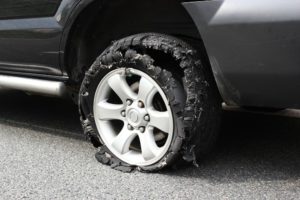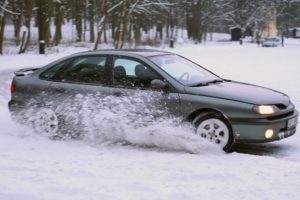Don’t Let Driving Emergencies Take You by Surprise
Most Common Driving Emergencies
There are two golden rules to remember when driving – expect the unexpected and be ready for anything. Many agencies, such as the National Safety Council, have compiled listings of the most common driving emergencies and the ways that drivers can best handle them safely. Let’s look at six of them:
 1. Blown Tire
1. Blown Tire
If you encounter this driving emergency, don’t over-steer. But do maintain a firm, steady grip on the wheel to keep the vehicle going in the desired direction until you’re able to slow it down.
Keep in mind that a front blown tire will cause the vehicle to pull toward the blowout’s side, while a rear blown tire will cause the vehicle’s rear end to weave. Apply your brakes smoothly and slowly enough that you can pull the car to the side of the road at a safe speed. Never immediately swerve to the side of the road or jam on the brakes as you could lose control.
2. Blown / Malfunctioning Headlights
Slowly brake and come to a stop on the right shoulder. Try to get as far away from passing traffic as possible. Turn on your emergency flashers, if they’re still operational, and place road hazard markers or flares at least 300 feet from the rear of your vehicle.
If you don’t have a cell phone to call for roadside assistance, then you can open the hood and try to scrape the battery cable’s lead terminal posts and the inside of connector lugs. This may provide a better connection and enough intermittent light to make it to a phone. As a last resort, you could use your emergency flashers as an intermittent light source if they’re on a separate circuit.
 3. Skidding Vehicle
3. Skidding Vehicle
This is a common driving emergency during weather events, like snow, ice or rain.
Remove your foot from the gas. Steer into the direction of the skid until you feel your rear wheels get traction again. Now, straighten the wheel. Never jam on the brakes or over-steer during the skid. To avoid skidding to one side when you need to come to a sudden stop, you can rapidly jam and immediately release the brakes. For those with anti-lock brakes, keep your foot on the brake and continue firm pressure while steering.
4. Engine Failure
Turn your right signal on and let the vehicle’s momentum carry you to the shoulder. If this isn’t a possibility, then remain in your lane or along the right side. Pump your brakes and turn your emergency flashers on to let other drivers know you’re in trouble. Once you’ve come to a stop, you’ll ideally exit the vehicle on the side without traffic flow. You can alert other vehicles by placing reflectors or flares; keeping your taillights on; and placing a white cloth around your handle, spoiler, or antenna. Use your cell phone to call for help or flag down a law officer. There may be an emergency call box on long bridges.
5. Stuck Accelerator
Turn off the ignition and apply the brakes. Keep in mind that your power assist feature will no longer work and braking and steering will be more difficult. Never lean down to handle the gas pedal, but you can try to lift the pedal with your toe if the pedal and throttle linkage have a positive connection.
6. Brake Failure
If your brakes still functioning properly, but you have a system light indicating a brake failure, then you should slowly take the most level route to a service station or mechanic shop.
If your breaks don’t feel normal, but are still offering some resistance, then pump them rapidly. This action could build enough hydraulic pressure to slow your vehicle down. You might be lucky enough to have a clear road and be able to coast to a stop or roll and apply your parking brake. Use your horn and flash your lights to alert pedestrians and other vehicles. You might need to carefully sideswipe hedges, snow banks, parked cars, and/or guardrails to help your vehicle stop if your on a downward, steep roadway.
Never swerve to the left of a vehicle in your path unless it’s your only choice. If you’re headed straight for another vehicle, firmly press the brakes; head for a shoulder, ditch, or open ground on the right side; and try to alert others with your horn.
Driving emergencies are hard to think through as they’re happening. For the best outcome possible, you’ll need to know what the potential emergencies are, know how to safely deal with them ahead of time, and make the subjects part of your family’s safety discussions.
